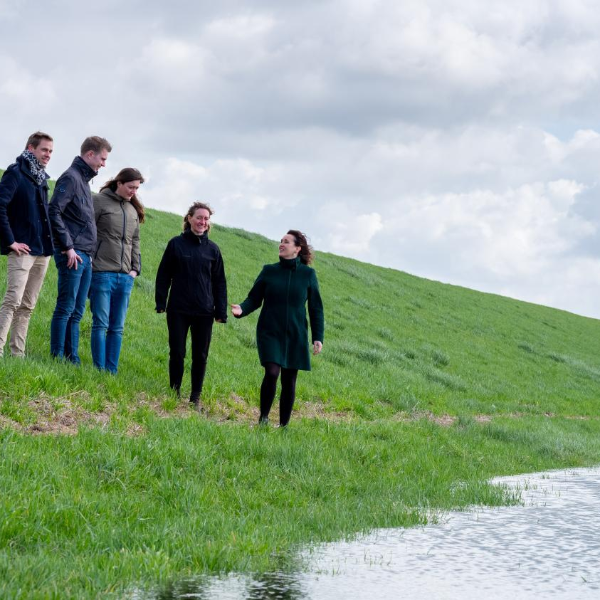Wolferen-Sprok dyke reinforcement: anticipating new nitrogen regulations

Wolferen-Sprok dyke reinforcement: anticipating new nitrogen regulations
It’s early 2019. The De Betuwse Waard design team, of which Witteveen+Bos is a member, is starting work on the Wolferen-Sprok dyke reinforcement project. Preparations for the Nature permit application are well underway. And then comes the PAS ruling by the Council of State, which has the potential to seriously derail progress. The design team shifts into a higher gear to find a solution to this new situation. Fortunately, the possibility of a change to the nitrogen regulations was taken into account at the start of the collaboration. As a ‘construction team’, the design team is working hard to complete the 13 kilometres of dyke reinforcement with fewer nitrogen emissions.
Wijnand Jelier, Wolferen-Sprok project control manager representing client Rivierenland water authority and Alice Esmeijer, ecologist at Witteveen+Bos, are busy thinking up measures to mitigate or compensate the nitrogen deposition caused by this project. Alice: 'This is a massive challenge. At Witteveen+Bos, we anticipated the failure of the PAS. At the start of this project phase, we therefore identified and incorporated the risk in the risk dossier. So when the Council of State announced on 29 May last year that the PAS had no legal standing, we were able to switch to a different schedule and implement our plan B.
Evidence
‘But that didn't solve the problem,’ adds Alice. ‘Policy-makers in The Hague were rather caught by surprise by the Council’s ruling. So there were no guidelines in place on how to deal with it so that projects could go ahead. At national level, for example, the Aerius model provided by the government is used to calculate nitrogen emissions. Following the ruling, Aerius was offline for months while it was being tweaked, so you couldn’t do any calculations. Aerius was mandatory under the PAS, but since the Council’s ruling, all references to Aerius have been removed from the legal texts. Now you can basically use anything you want as long as you can prove it’s correct. We have been working hard on this ever since.’
Deadline
Wijnand: ‘The Wolferen-Sprok dyke reinforcement is being financed from the national Flood Protection Programme. That means that there are certain conditions attached, such as a clear deadline when the project needs to be ready. Exceeding this deadline is an expensive business.’
Alice: ‘Therefore, we’ve opted for a multi-pronged approach, and we calculate whether there is actually a problem in the current situation. We are also exploring options for internal or external netting. Carrying out ADC tests (demonstrating no alternative, compelling reasons of public interest, compensation for damage to nature) might also be a possibility.’ Wijnand: ‘And we’re running these solutions simultaneously because we’re working under time pressure.’
One potential solution is, for example, internal netting. Alice: ‘In the planning stage of this project, in which we were also involved, it was decided that we didn’t want to remove any farms, so internal netting (offsetting emissions within the project area) actually leaves too little room for manoeuvre to comply with the requirements. So we wanted to net externally by buying emission rights from farmers, but the water authority asked us to come up with something else. So now we’re looking for ways that will still allow us to do that internally. For example, widening dykes takes up space and destroys the habitats of some species. We have to try to compensate for that, and that can be done by letting plots of grassland become overgrown. Or by adapting the permits of land leased by the water authority, so that no fertilisation takes place there with immediate effect. This will eliminate nitrogen emissions from large areas of grassland as a result of the project. If we can prove this, we’ll be well on the way.’
Added value of the design team
Wijnand: ‘The dykes themselves don’t produce nitrogen; all nitrogen emissions in this project are caused by the work activities during the implementation phase. We are looking for ways to reduce our own emissions. One thing that really helps here is that the contractor is also part of the design team. If contractors had to calculate all this themselves, I don’t think there would have been the capacity in the current market. Now the lines are very short. For me, it's clear that such a design team works, that you get solutions through working together. We can also have very concrete discussions about what other construction equipment we can use that will allow us to do the work and still achieve a big reduction in nitrogen emissions.’
‘If we didn’t already have the contractor on board, we would never have been able to reduce nitrogen emissions as much as we have. This helps us move forward, which is crucial with this tight deadline. A common challenge also helps create team spirit. For example, I've never worked so intensively with an ecologist in a project before.’